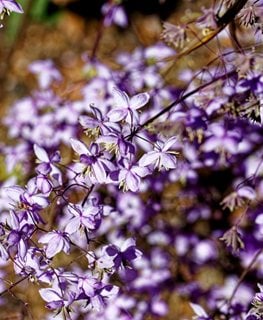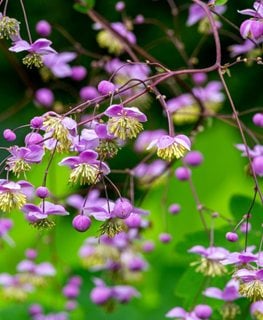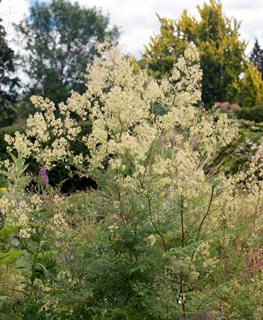HOW TO GROW & CARE FOR MEADOW RUE (THALICTRUM)
Everything you need to know about planting, cultivating, and troubleshooting this easy-care perennial.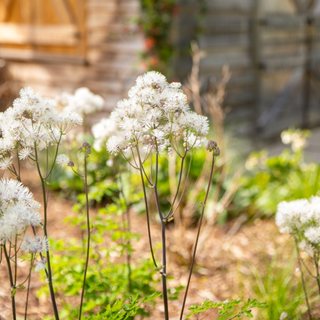
Cotton ball meadow rue. Photo by: Anna Cross / Shutterstock
With its feathery foliage and ethereal blooms, meadow rue (Thalictrum) brings a quiet sophistication to shaded borders and woodland gardens. Often overlooked in favor of flashier perennials, this graceful plant offers subtle beauty and an airy vertical form that adds movement and softness to the landscape. Whether you're designing a cottage-style retreat or a naturalistic planting, meadow rue quietly captivates without ever commanding the spotlight.
Here, we give you guidelines for growing meadow rue successfully—from choosing the right variety to planting, pruning, and managing common pests and problems. Whether you're a seasoned gardener or just discovering Thalictrum, this article will help you keep it thriving season after season.
On this page: Basics | Planting | Care | Pictures | Frequently Asked Questions
On this page:
MEADOW RUE BASICS
Botanical name:
Thalictrum spp.
Common name:
Meadow rue
Plant type:
Herbaceous perennial
Zones:
4-8, with some species hardy as far north as Zone 3
Native range:
Much of the Northern Hemisphere, including North America, Europe, and Asia, depending on the species.
Exposure:
Part sun to full shade
Habit:
Upright
Height/Spread:
1 to 8 feet tall, 1 to 4 feet wide (depending on the species)
Bloom time:
Typically, from late spring through summer, although some varieties flower later in the season, making it possible to extend the bloom period by planting multiple species with staggered flowering times.
Flowers:
Small, delicate blooms in shades of lavender, pink, yellow, or white are borne in airy panicles or racemes above the foliage. Instead of petals, each bloom is made up of clusters of stamens, giving them a soft, pompom-like appearance. Although some species produce fragrant flowers, not all are scented.
Foliage:
Typically divided into multiple small leaflets resembling those of columbine or maidenhair fern. The color ranges from shades of blue-green to soft green.
Landscape uses:
Woodland gardens, meadow gardens, back-of-the-border accent, cottage gardens, pollinator gardens, rain gardens.
“Meadow rues are a diverse group of perennials well-suited to a variety of garden settings, including sunny borders, woodlands, and rockeries. The wealth of meadow rues available to gardeners ensures a profusion of pretty blossoms from spring into fall.”
— Richard Hawke, Plant Evaluation Manager, Chicago Botanic Garden
HOW TO PLANT MEADOW RUE
When to plant:
Plant nursery transplants in the spring to give the roots a full growing season to become established. Fall works best for sowing seeds.
Where to plant:
Most meadow rue species prefer part to full shade, but some tolerate full sun in cooler climates. In hot or dry climates, choose a spot with morning sun and afternoon shade or dappled sunlight.
How to plant:
Dig a hole that is as deep as the root ball and twice as wide. Place your plant in the hole, ensuring the crown is level with the surrounding soil. Fill the hole with soil, tamp down gently to remove air pockets, and water thoroughly. Water plants regularly until established.
Soil:
Many species of Thalictrum are native to moist woodlands and do best in rich, loamy soil that mimics those conditions. The key is that the soil be well-drained, since these plants will not tolerate waterlogged conditions. Adding compost or other organic matter is a good way to improve the soil texture for meadow rue, especially if your soil is heavy clay.
Spacing:
Space meadow rue plants according to the mature size of the specific cultivar you’re planting, allowing enough room for good air circulation to reduce the risk of fungal diseases like powdery mildew. For tall, slender varieties, you can plant them closer together in clusters to allow them to lean on one another for support, which may reduce the need for staking.
Growing from seed:
Meadow rue is relatively easy to grow from seed, but it requires a bit of patience and preparation. Because the seeds have built-in dormancy mechanisms that prevent immediate germination after dispersal, it’s often best to sow them outdoors in the fall, allowing for natural cold stratification over winter. Alternatively, you can simulate stratification by chilling the seeds in the refrigerator for 3 to 4 weeks before planting.
Once stratified, sow the seeds on well-draining, organically rich soil, pressing them lightly into the surface, since they require light to germinate. Keep the soil consistently moist but not waterlogged. Germination typically occurs within 2 to 4 weeks, though it may take up to a month or longer, depending on conditions.
MEADOW RUE CARE
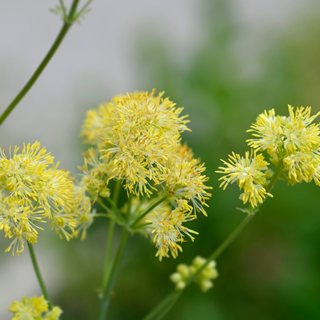
Yellow meadow rue. Photo: nahhana / Shutterstock
Watering:
Water meadow rue regularly, especially during dry spells, aiming to provide about an inch of water per week, including rainfall. Plants grown in full sun may need more frequent watering to prevent the soil from drying out. It’s important to keep the soil consistently moist but not soggy, since overly wet conditions can lead to root rot. To reduce the risk of fungal diseases like powdery mildew, water at the base of the plant to avoid contact with the foliage.
Amendments & fertilizer:
Fertilizing meadow rue is typically unnecessary when grown in rich, fertile soil. However, if your soil lacks nutrients, consider working in some compost and applying a balanced, slow-release fertilizer in early spring as soon as the first leaves emerge to support healthy growth. If flowering is sparse later in the season, a light follow-up application can help stimulate bloom production.
Pruning and deadheading:
Pruning meadow rue is more about managing its size and maintaining a tidy appearance rather than shaping. If the plant becomes too dense or floppy, selectively remove a few stems to improve air circulation and minimize the risk of fungal diseases. After the foliage dies back in the fall, you can cut the plant down to ground level.
Although deadheading isn’t strictly necessary for meadow rue, it can enhance the plant’s appearance and may extend the bloom period. Regular deadheading also helps reduce the likelihood of self-seeding.
Support:
Taller varieties may benefit from staking or other support. If planted in too much shade or over-fertilized, plants are more prone to flopping and may require support.
Propagation:
By seed or by dividing established clumps in early spring when new growth begins.
Overwintering:
In northern climates with harsh winters, a few preventive steps can help ensure your meadow rue returns strong in the spring. Once the foliage dies back in late fall, cut the stems down to the ground to reduce the risk of disease. Also apply a 3- to 4-inch layer of organic mulch, such as shredded leaves, straw, or bark, over the root zone to insulate the soil and protect the roots from freeze-thaw cycles.
During winter dormancy, meadow rue needs very little moisture, so water sparingly and make sure the soil drains well.
Pests and diseases:
Meadow rue is generally free of serious pests or diseases, although powdery mildew and leaf miners are occasional problems. It is rarely browsed on by deer or rabbits.
MEADOW RUE VARIETIES
FREQUENTLY ASKED QUESTIONS
Is meadow rue invasive?
Although Thalictrum can self-sow in the garden—especially if the spent flowers aren’t deadheaded—it is not considered aggressive or invasive. To prevent unwanted spread, simply cut back the flower stalks before they go to seed.
Does meadow rue need staking?
Taller species of meadow rue will likely need some support to prevent them from flopping over in windy or rainy conditions. It’s best to stake plants early in the season before the stems elongate, using supports like bamboo garden stakes or grow-through rings. You can also group plants together so they support each other naturally.
Can meadow rue be grown in containers?
Yes, as long as you use a pot large enough to accommodate its tall stems and fibrous roots. Because Thalictrum prefers consistently moist conditions, be sure to use rich, moisture-retentive soil with good drainage and water plants regularly. To protect container-grown plants from freezing temperatures and root damage during harsh winters, move them to a sheltered spot such as an unheated garage or shed.
Should meadow rue be cut back after flowering?
Removing spent flower stalks isn’t essential, but it helps maintain a tidy appearance and prevents self-sowing. In late autumn, once the foliage has died back naturally, you can cut the plant to the ground to prepare for winter dormancy. Or if you prefer, leave the seed heads standing for winter interest and to support wildlife.
Is meadow rue toxic?
Although Thalictrum is generally non-toxic to humans, it contains protoanemonin, a chemical compound that can irritate the skin and may be harmful if ingested in large quantities. While it's safe to grow in most gardens, you should take precautions if you have pets or small children. Also consider wearing gloves when handling the plant.
ABOUT THE AUTHOR
Anne Balogh is a longtime gardening writer and editor for Garden Design, with over 20 years of experience covering everything from container planting to landscape trends. She draws inspiration from her own Zone 5 garden in Illinois, where she experiments with hardy perennials and flowering annuals.
RELATED:
Native Plants & Native Gardens
20+ Cottage Garden Plants & Flowers
